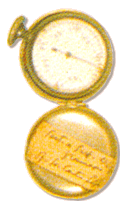The thermometer
|
|
(Left)
Steel Case with flannel dressing (3,2x3,2x1,3cm).
Immischs thermometer: Steel, glass; 19th century; 4x2,8x1cm.
Belonged to Professor Gramaxo.
Donation from Mr. Castro Lopes.
(Right)
Wooden case with pergamoid, satin and velvet dressing (3,5x45x5cm).
Differential thermometer from H. Roberteau: Glass and mercury; Breveté SGDG. |
The evaluation of body temperature was part of the objective patient examination since the most remote ancient times. However the science and the technology of those times would not favor the project and manufacture of any instrument susceptible of quantifying the temperature of the body. Galileo Galilei (1564-1642) is thought to have been the first to know and to use an instrument that quantified heat. This was an instrument with no scale or fixing points, an open-air thermoscope. The results provided by this instrument depended on variations of heat and atmospheric pressure. Around 1610 Cornelius Drebbel (1572-1634) introduced his
"heron experiment" in which he demonstrated the dilating action of heat over the air. His thermometer became known as the
"Perpetuum Mobile". In 1614 Santorio Santorio (1561-1636) presents his
"Instrumentum Temperamentorum" which he oriented for clinical purposes. His instructions for the use were that the thermometer should be applied in a certain region of the body for a determined time and several times during each disease. The regarding of these instructions would make this instrument a valuable diagnosis auxiliary. His objectives were never attained. The first records regarding the first closed
"wine spirits" thermometer belonged to
"Academia del Cimento" (Florence, 1567). In 1665, Robert Boyle (1626-1691) proposed as a fixed point the freezing temperature for the anise oil. Christian Huygens (1629-1695) suggested for the first time the temperatures of water ebullition and freezing as fixed points. Several substances were tested, like the linseed oil, air, wine spirit and mercury, among others. The calibration of the tubes containing a mercury drop represented a significant progress in the optimization of the thermometer. The type of separators still used in thermometric scales is connected to the names of G. Fahrenheit (1686-1736), Réaumur (1683-1757) and Anders Celsius (1701-1744).
Among the most renowned, the Maximiano Lemos Museum owns the differential thermometer of H. Roberteau and the Immisch thermometer, in exhibition in the
room João de Meira.
The differential thermometer, a Leslei's invention, was only available to quantify small differences of temperature. It was made of two glass spheres connected at the bottom across a thin tube, which was a reservoir of a colored liquid. A small difference in the temperature between the two spheres produced a difference in the liquid level, registering the temperature.
The Immisch thermometer is different from all the others because of its small dimensions. Its working system is based on the principle of body dilating with heating.




